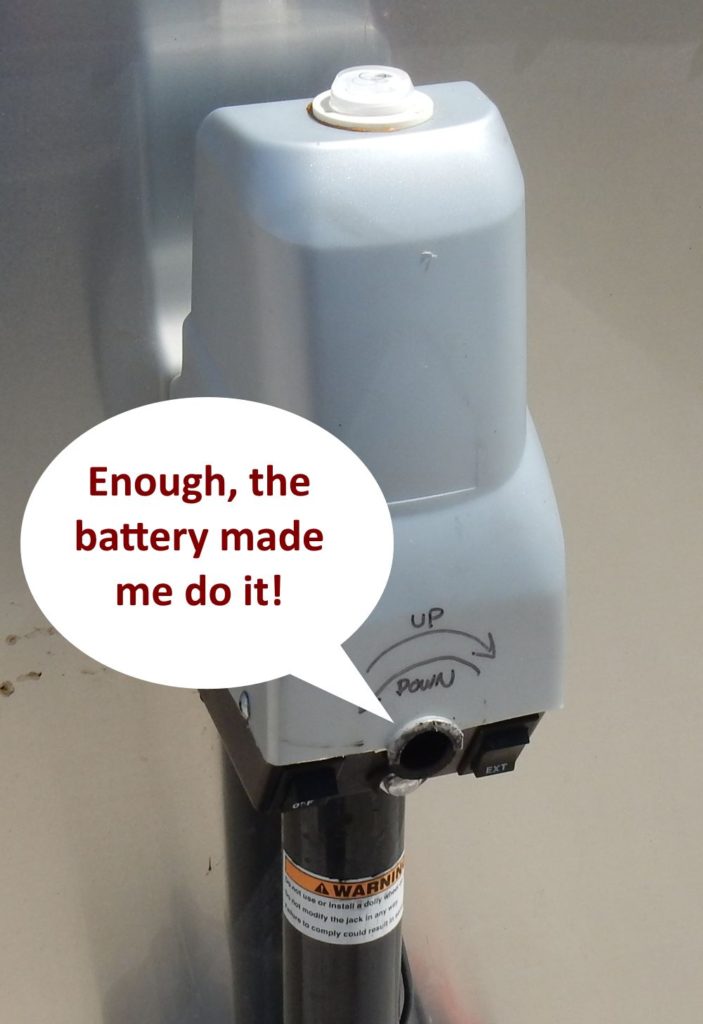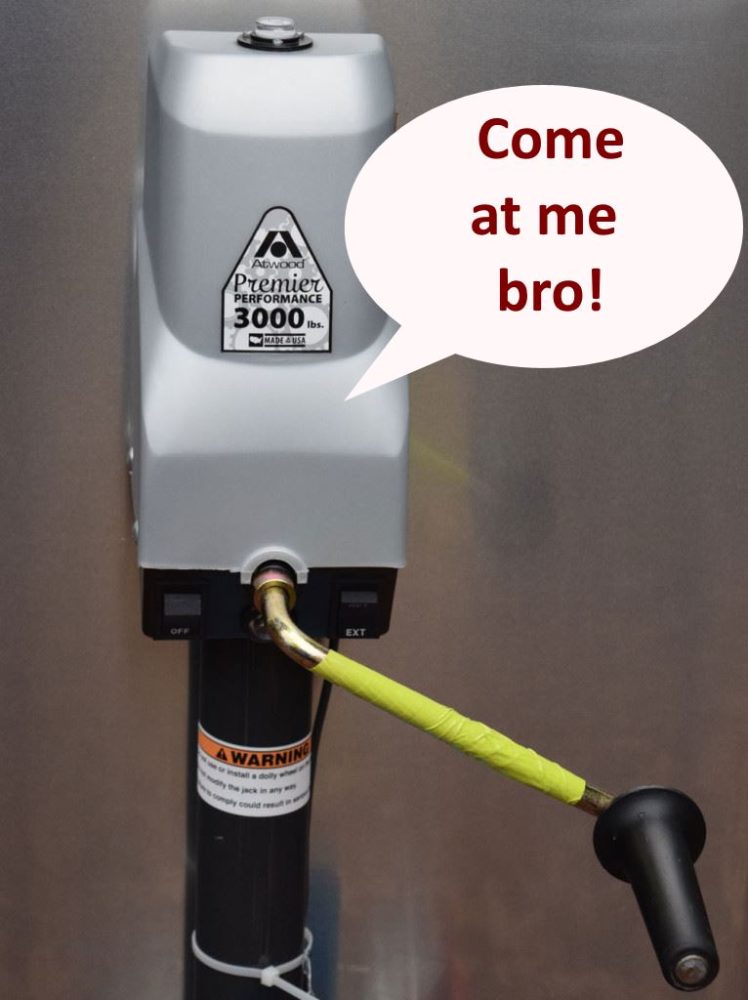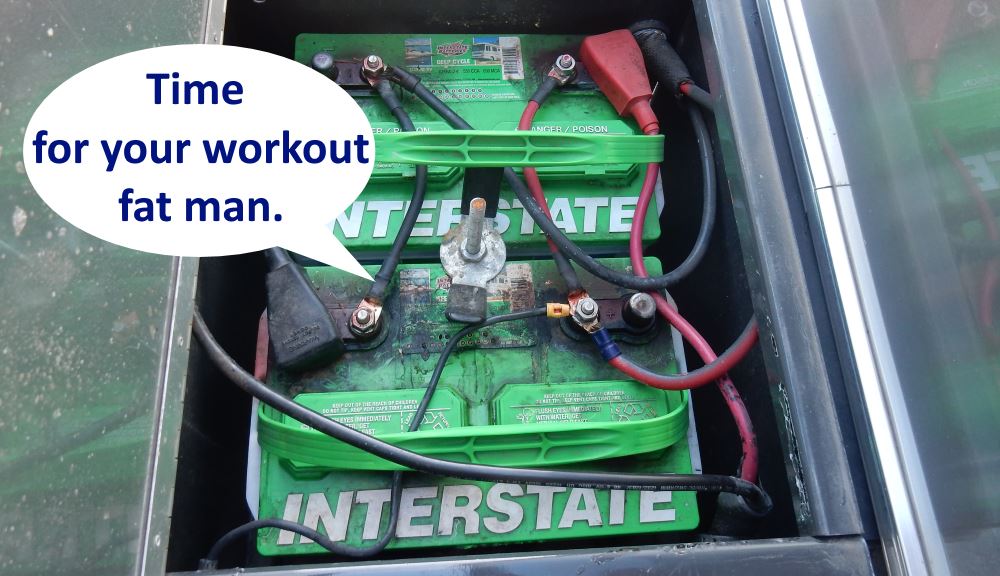It has been a while since our intrepid crew has faced off against our old adversary, the Atwood 3000 power jack. Our last encounter was Trail and Hitch vs the Immovable Object way back in November 2015. Well, my friends, this villain has returned and this time had earned the sinister nickname, “Cranky Jack.” Old Jack gave us quite a fight, and in the end, taught us some valuable lessons. Grab a grog and gather round as I tell the tale.
Darkness Stirs
The trouble began as we set out to leave our winter bunker of two months in Mission Texas. The morning of our departure we discovered the power jack on our Airstream refused our commands to raise or lower the trailer. Only silence greeted our flipping of the up and down switch. Our first suspicion was it had gotten a bit stuck as it had back in the Immovable Object challenge so we dug out the manual crank and I had a go.
After 2 months of not much more than sitting around and writing, I was not in good condition for hand cranking a 9K pound trailer. Making matters worse, instead of the low growling whine, Cranky Jack is supposed to make when handled thusly, he instead made a loud “Thunk Thunk Thunk” sound as the handle jerkily stuttered under my efforts. It felt like the gears were slipping rather than turning smoothly, making the task significantly harder and giving us further concerns.
Investigation Begins
Trail called for emergency exploratory surgery on old Jack. We took apart his plastic shell and poked around a bit at his innards. Everything looked normal enough. The few gears we could see appeared well fitted. We greased them a bit for good measure, looked at the electrical connections, all of which seemed fine to our untrained eyes. Eventually put him back together and tried the switch again to no avail.
Trail next turned her baleful eye to our batteries, which she claimed had been acting a bit suspicious as of late. She noticed one smoking a bit when refilling it and at only a year old they are much too young to be smoking. We decided to hook up shore power to test this theory but Cranky Jack remained silent despite the guaranteed power source. By this point, we were out of guesses and had to get on the road so I Thunk Thunk Thunked until I got the trailer hitched and we could get on the road. Unfortunately, the next repair place was near Dallas, 2 stops away from Mission.

Texas has the coolest cows of anywhere we have been. These longhorn cattle are great, so are the Brahman. What the heck else am I going to illustrate an article about a cantankerous power jack with?
Cranking Along
Old Cranky Jack and I got to be on rather intimate terms. I discovered that with some finesse, I could coax him into stopping his Thunking and get a nice smooth turn of the crank. When he wanted to behave, that made things much easier, when he didn’t, like the time we had to leave in the pouring rain, it was rather hellish going. On the positive side, my arms were getting a very nice workout every other day.
Arriving in Dallas we tried to set up a service appointment. Our first pick turned out not to do warranty work. Our second option did warranty work but didn’t have an appointment for another four weeks and that would be just to look at the darn thing. The were very helpful in asking if we checked the fuse. “Which fuse?” we asked. “The one directly leading to the jack,” he said, “that is the problem 9 times of 10.” Hope dawns! “I’ll check on that and call you back,” I told him. We actually had checked for fuses on the way out since our manual mentioned it, but we didn’t find the thing and it wasn’t clear where it was. All the fuses we could find looked fine, but faced with a 3-week delay in our journey, I was more motivated.
A New Hope
I crawled under the Airstream near the jack to give it a detailed look, not a comfortable position for a man of my size, but lo and behold I found it. It’s actually just a junction in the power cable leading from the jack to the batteries and if you pull the cable apart, the fuse is inside. Sure enough, it was blown! Huza, our problems were solved, get a new fuse and we are on our way. We drove over to an auto parts store, laughing at ourselves and picked up a new fuse.
But we would not have the last laugh. Cranky Jack had other things in mind and on replacing the fuse he remained stubbornly silent to our commands. We needed a new plan. Staying a full month in Dallas put us out of timeline for our further travels and we were learning there was no such thing as a quick appointment with a warranty service center. My new plan was to pick a spot where we would be staying for a week or more at least 4 weeks down the road where there was a service center. That ended up being Orlando, Florida. I called them up and booked a date for servicing Jack.
So we hand cranked our way to Orlando Florida from Dallas Texas. Cranky had his good and bad days but before too long we made it to Orlando in time for our service appointment. While my arms were feeling swole from the exercise, by the time we’d arrived the hand crank was starting to fall apart and metal shavings were coming of Cranky Jacks crank hole. Clearly, it was not intended for long term abuse of this kind.

Florida has the best reptiles, including this fellow. He gave us a great pose. Lots more to come on this guy and his buddies in future articles.
Lessons Learned
Trail had a good idea to scout out the service center ahead of time. It seemed silly to me but it turned out to be a wise move. Firstly, this shop was right in the middle of an urban area so the route to bring a 30′ airstream there was not an easy one. Also, there was significant construction in the area. Even though it meant some extra gas and time, we were able to sort the best route and not have to do any guesswork when it came time to take the trailer there. We also talked with the technicians to see how long they would need the trailer for so we could figure out what to do with the cats.
While talking to the service center folks, they noted our Washington state plates which pretty much amounts to a far and exotic land in Florida. We proudly mentioned we were full timers as we usually do. Their faces went dark for a moment and they said something like, “I didn’t hear what you just said, living in your trailer voids your warranty.” “Right, I said we are having a great time on our Florida vacation,” I replied. Neither our dealer nor the other places we’d had warranty work done had mentioned this important bit of info and sadly we had not read the fine print. An important lesson learned.
The Final Fate of Cranky Jack
But what of Cranky Jack? Well, when we brought the trailer in they looked it over and noted that the batteries were dead and on testing them, their equipment called for them to be replaced. We’d had our suspicions about the batteries but it didn’t actually get in our way so we’d let them be. We asked for them to be replaced. Once that was sorted, they looked at the Jack. It turned out that one of the wires was loose on the activation switch and that it worked just fine once connected to the new batteries. Old Cranky Jack was not so cranky after all, just a victim of circumstance.
With all the evidence at my disposal, I mentally reconstructed the series of likely events. First, our batteries went bad. That likely caused the fuse to blow out. In our attempt to figure out what was wrong we opened the jack up and likely inadvertently disconnected the switch wire while putting it back together. Later when we fixed the fuse, the wire had come loose so it still didn’t work leading us to think it was just broken. If we’d done a better job maintaining the battery, we’d not have run into this series of unfortunate events.

As you can see, Jack has suffered a bit of hardship since we took his picture back in 2015 (as seen in the cover image).
The Aftermath
That brings us to our last lesson. For a while now, Trail and I have disagreed about what to do with our battering disconnect switch. I recalled the dealer telling me to always leave it on unless you were putting the RV into long term storage. Trail felt that it should only be on when not connected to shore power so she turns it off most of the time. Trail tends to “win” such arguments so she turned it off when we were on shore power and when towing.
Well, since the batteries had died, I re-opened the great debate. Fortunately, at the service center, there was an Airstream technician who Trail agreed would be the final word on this disagreement. I am not shy to report my triumphant victory. The service technician confirmed that you should leave the battery connected at all times, only turning it off for long term storage. Further that an RV parked at home should be plugged in once a week at least to keep the batteries charged. And finally, the clincher, that turning the switch off is a good way to destroy the batteries. Trail graciously accepted the judgment and we agreed in future the switch would stay on.
So our tale ends as so many of life’s challenges do, with us a little poorer in cash, and a little richer in knowledge. Cranky Jack has returned to grace as the honorable Admiral Atwood and we continue our journey of discovery.







6 Comments
The latest versions of the modern power converters already have smart battery chargers built into them as part of that system. Those newer types of built into the power converts will condition the batteries. As Airstream is a high end product it does have that type of power converter. Therefore they do not need to purchase an additional smart battery charger as suggested in the comments.
I did some research. Unfortunately, while Airstream does use a lot of high-end components, the battery charger isn’t one of them. I looked it up and ours is not a smart charger, just a single stage one. Judging by forum posts on air-forums, it’s been a long-standing complaint and target for upgrade among aficionados. I don’t think we will replace ours unless it proves to be a problem. So far as I can tell the issue we had was due to not using the equipment properly. BTW: ultimately the battery replacement was not covered under any warranty as the batteries are only covered by their manufacturer for up to 12 months.
Great story telling! It’s tough to make a mechanical issue interesting to read! (btw, your site comments are throwing an error. You also might want to post or cross-post on Medium)
Thanks Tony. I had a good time putting this one together even if the events themselves were not fun at all.
Great story with so much application, thank you for sharing your experiences! What about the metal pieces discovered near the jack handle insertion point? You may want to add a battery charger/conditioner to your tool kit. I use mine frequently to top-off my automobile battery after weeks of frequent cold-weather starts or when the kids drain the battery by leaving a dome light on. Pick a smart charger because it will both condition, charge and then maintain. Select one that will not charge at a rate greater than 20% of your battery’s amp-hour rating. My model is no longer made, but I’ve been impressed with a product I own from NOCO and this model would charge or maintain both of your batteries simultaneously. I am not related to this product, nor benefit from making a recommendation. Best wishes, Robb
NOCO Genius GENM2 8 Amp 2-Bank Waterproof Smart On-Board Battery Charger: http://amzn.to/2ntkjsQ
Thanks Robb. The metal shards… they were from friction when cranking the jack. I was a bit shocked at how much friction turning the crank created.
Our airstream comes with its own built-in charger that is buried somewhere under the couch. It sounds like the one you are linking to is a better unit than the one we have built in. Thanks for the recommendation!